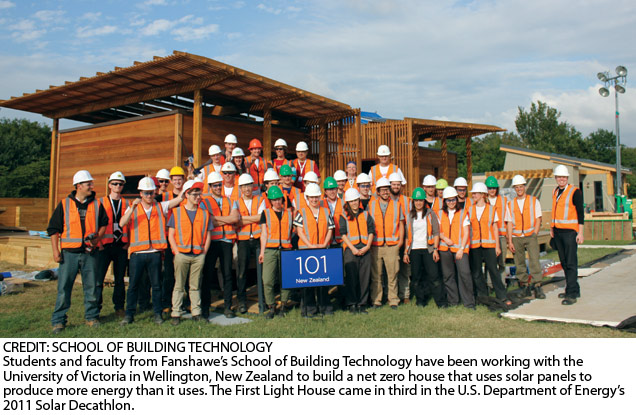Fanshawe students team up with New Zealanders to build green

For over a year, students and faculty from Fanshawe and the University of Victoria in Wellington, New Zealand, have been holding videoconferences, sending hundreds of emails back and forth and working together overseas to build a house.
The partnership came about for the Solar Decathlon, a contest held by the U.S. Department of Energy for post-secondary students from 20 universities around the world to show off their green building design skills. The teams are judged in 10 competitions, including architecture, market appeal, engineering, affordability and energy balance. According to the Solar Decathlon website, "The winner of the competition is the team that best blends affordability, consumer appeal and design excellence with optimal energy production and maximum efficiency."
The New Zealand team, with the help of Fanshawe students from the School of Building Technology, placed third in the competition. They were the first team from the southern hemisphere to ever compete in this competition, and they are also the highest-placing first-entry team. The house placed first in the Engineering category, and it was noted by a professor from the University that this would not have been achievable if it had not been for the students and faculty of the Fanshawe College School of Building Technology.
"(The team from) New Zealand was the main designer of the whole project," explained Joel Foster, who was on the assembly and disassembly teams in Washington. "(Fanshawe worked on) more of the engineering and construction side of it — the handson, technical side of it. A lot of hours went into the engineering and the construction of the actual building and modules, which is what our school primarily does."
The 950 square foot 'First Light House,' so named because New Zealand is the first country to see the sunlight each day, was built as a 'kiwi bach' — a summer home. Foster explained one of the important criteria for the home was that it was net zero. "Net zero means it produces more energy than it actually consumes," he explained. "The way they did that is using photovoltaic panels, which is a fancy word for solar panels."
Wendy Wilson, liaison for the project and Coordinator of Technical Programs for the School of Language and Liberal Studies here at Fanshawe, added some more details about the house: "The cladding — the exterior — is made of Western Canadian red cedar. The interior is all indigenous New Zealand wood. The insulation is wool from carpet ends � they make a lot of wool carpet in New Zealand. There are 28 solar panels on the roof. It was designed in a butterfly pattern and the decking went through the centre."
In addition to the numerous videoconferences and emails, students did a lot of travelling. In January this year, three students from Fanshawe's Architectural Technology program — Spencer Marcolini, Josh Hoggard and Shaun Haskett — travelled to Wellington to assist with the construction of the house.
After building and displaying The First Light House in New Zealand, the structure had to be deconstructed and shipped to the National Mall in Washington, D.C for the Decathlon. It was rebuilt at the Mall with help from more Fanshawe students and faculty: Foster, Matt Stewart, Shawn Douglas, Jason King, Jeremy Gardner, Tyler McLean, Haskett, Stephen Hotke, Professor Marty Askes and Professor Dave Sleegers.
Once the competition finished, the house had to be disassembled once again to be shipped back to New Zealand. The Fanshawe students and faculty who assisted with disassembly were Foster, Darcy Comerford, Spencer Vermue, Juduk Lee, Ben Gerber, Kyle Kane, Professor Sandi Burns, Professor Rob Geoghan- Morphet and Professor Askes.
Though the teams worked well together, they did encounter a few minor problems. "The one funny thing was the language barrier," laughed Foster. "For example, our 'flashlight' is their 'torch.' They would be talking about a certain tool, and we'd be like, 'What are you guys talking about?' And then we would be talking about the same tool, and they'd just be like, 'What?'"
Despite the minor road bumps, both Foster and Wilson were extremely proud of the work that had been done. "I thought the (Fanshawe) team was absolutely fantastic," said Wilson. "One of the professors from New Zealand said they were a joy to work with, hardworking, honest, reliable, and I totally agree with him. They were just a great team."
The First Light House has been purchased by someone from New Zealand, who plans to use it as a summer home.
For more information about the Solar Decathlon, visit solardecathlon.gov. For more information about The First Light House, visit firstlighthouse.ac.nz.













